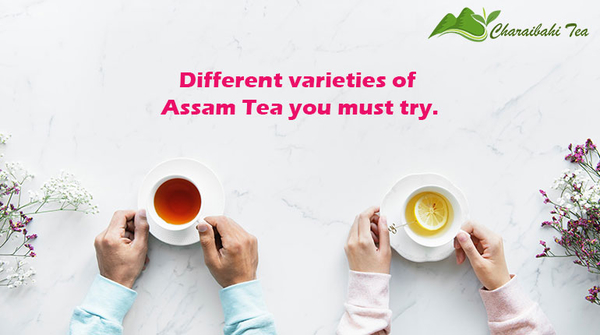Tea has been enjoyed for centuries and is one of the healthiest drink choices. In most of the western world coffee is the drink of choice but when it comes to the Eastern part of world tea is the drink of choice. Generally, the variety of tea is divided based on how they are processed. The state of Assam which includes the middle Karbi, Cachar Hills, northern Brahmaputra Valley, and southern Barak valley is home to contiguous tea-growing parts of the world. Globally Assam is the only region where tea is grown in plains. After China Assam is the only region that has been growing its native tea plant. Assam tea is quite popular globally.
Assam tea has a deep-amber liquor, full-bodied, rich, strong, brisk and a malty taste. It is ideal for early morning sip. The second flush orthodox Assam tea is quite popular as it has bright liquor and distinctive taste. Orthodox Assam tea is registered as a GI(Geographical Indication) in India.
Listed below are different varieties of Assam tea you must try:
White Tea:
Talking about the white tea, it is lightly oxidized and it was primarily harvested in China. You get white tea from the leaves and buds of the Chinese Camellia sinensis plant. The buds and tea leaves are allowed to wither in the natural sunlight before being lightly processed to prevent further tea processing and oxidation. The name ‘white tea’ is driven from fine white and silvery hairs on unopened buds of the tea plant. This gives the plant a whitish appearance. This tea itself is not colourless or white but it is somewhat pale yellow.
Yellow Tea:
Yellow tea is a special tea which generally implies a special kind of tea processing which is similar to green tea. It is processed through a slower drying phase. Here, the damp tea leaves are allowed to sit till it turns yellow. Yellow tea has a yellow-green appearance and it smells completely different from both green tea and white tea. Its aroma is sometimes mistaken for black tea if it is cured with other herbs. You may find some similarity in taste between green tea, yellow tea, and white tea. It describes high-quality tea.
Green Tea:
Assam green tea is made from the leaves of Camellia Sinensis. It has undergone minimal oxidation while processing. Originated in China, it has become a popular drink in Asian countries. In present days green tea has become the raw material for extracts which is used in beverages, cosmetic items, health foods, and dietary supplements. In the countries where it grows, many varieties of green tea have been created. The varieties of green tea may also differ substantially. It may be because of variable growing conditions, harvesting time production processing, and horticulture. It comes up with numerous health benefits and you will be surprised to know about it.
Oolong Tea:
Oolong tea is extracted by withering under the strong sun. It is oxidized before twisting and curling. The fine quality oolong tea mostly involves varieties which are specially used for particular varieties. The oxidation degree for this may range from 8-85% and it completely depends on the production style and variety.
Black Tea:
Talking about black tea it is more oxidized than oolong, white tea, and green tea. It is generally stronger in flavour as compared to the less oxidized tea leaves. There are two different ways of processing it. One method is CTC which means crush, tear and curl and the other method is Orthodox. The CTC method is effective and efficient for producing a good quality product even for lower quality or medium quality leaves. They are of consistent dark colour. The processing for orthodox is done either by hands or by machine. Hand processing is done for high-quality tea. The method employed for processing in orthodox differs by tea type. It retains flavours for several years if kept in an airtight container.
Fermented Tea:
From the name itself you can find that it undergoes fermentation. It is done in the open air and for many years and several months. When exposed in the open air for fermentation it goes through oxygen, humidity in the air and microflora. After being exposed it further undergoes fermentation, auto-oxidation and some reactivated enzymes in tea. After going through all these processes it completely alters the aroma of tea and mellows the taste. It turns the bitter and astringent tea into an unctuous and thick product. It gives pleasant aftertaste and mouth feels.
Many of us might not be aware of these many varieties of Assam tea. So, now when you know about all the varieties of Assam tea which tea are you going to sip tomorrow morning? All these variants have amazing flavours and are of great quality to energize you every morning. Assam tea is popular globally and people from different parts of the world desire to taste it. This drink choice is getting popular these days and they are consumed for great health benefits. To feel the difference in taste why not give a try to these varieties of tea.












